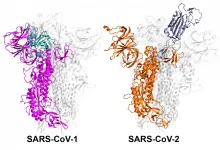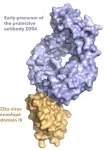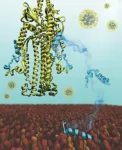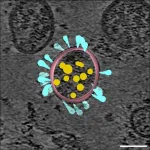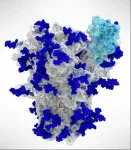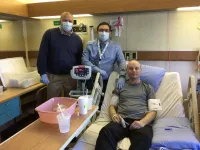(Press-News.org) UNIVERSITY PARK, Pa. -- When healthcare workers become ill during a disease outbreak, overall case counts and mortality rates may significantly increase, according to a new model created by researchers at Penn State. The findings may help to improve interventions that aim to mitigate the effects of outbreaks such as COVID-19.
"Each year dozens of potentially lethal outbreaks affect populations around the world. For example, Ebola ravaged western Africa in 2014; Zika damaged lives in the Americas in 2015; and now we are in the midst of a worldwide pandemic -- COVID-19," said Katriona Shea, professor of biology and Alumni Professor in the Biological Sciences, Penn State. "Healthcare workers are essential to providing care during such outbreaks. Yet, their exposure to the diseases they treat means they too may become victims of the outbreak. Conventional epidemic models do not usually consider this important driver of quality of care, and may thus underestimate epidemic burdens."
In their new model, the researchers investigated the direct impact of the loss of healthcare workers on outbreak outcomes. Specifically, they examined the impacts of healthcare workers becoming infected and unable to work on case counts and mortality. In the model, they refer to this as "loss impact." They also examined "redundancy," which they define as the minimum number of health care workers required to provide adequate care.
"When the loss impact is high, declines in quality of care for each infected healthcare worker are more extreme," said Amalie McKee, former PhD student at Penn State and now adjunct professor in analytics, Harrisburg University of Science and Technology. "Higher health system redundancy represents a healthcare system that is safeguarded and able to withstand the loss of more healthcare workers before it cannot provide adequate care."
McKee explained that the model assumes that quality of care determines the rate at which vaccines are administered, the probability of dying from infection and the rate of recovery from infection. The model also assumes that vaccines grant lasting immunity and that health care workers are vaccinated at a higher rate than the general population. It also assumes a basic reproduction ratio (R0) -- or the number of cases generated by one case in a population that is fully susceptible -- of roughly 2, which is roughly consistent with recent outbreaks of COVID-19, Ebola, pandemic flu and SARS.
In addition, the model assumes a 0.1% percent baseline chance of dying from disease, which is lower than that for Ebola and SARS, but a conservative estimate of mortality associated with COVID-19. Finally, the model assumes that healthcare workers are infected at a rate that is 50% higher than the general population.
The results will publish today (Feb. 25) in the journal Epidemiology and Infection.
According to the researchers, the model predicts that high loss impact --a large drop in quality of care for each healthcare worker that is infected -- paired with low redundancy --a healthcare system that is not able to withstand the loss of workers -- causes the most severe epidemic outcomes with respect to case counts and mortality.
"This outcome represents a fragile health system that has a rapid decrease in quality of care after only a few healthcare workers are infected," said McKee.
In contrast, the mildest outcome results from the combination of high system redundancy and high loss impact.
"This combination represents a strong health system with a minimal decrease in quality of care until nearly all healthcare workers are infected, McKee added.
Results of the team's model predict that when declining quality of care is considered, total disease cases could increase by up to 15% and the total number of deaths could increase by as much as 1,716%. The model also predicts that the number of vaccinations administered will decrease by 10.8% and the number of individuals that recover will decrease by as much as 8.9% when declining quality of care is considered.
"We demonstrate the importance of considering the loss of healthcare workers on epidemic outcomes," said Shea. "Addressing such losses will allow epidemiologists to anticipate, plan for, and mitigate negative outcomes."
For example, she noted, to address problems of low redundancy, in which quality of care drops significantly when only a few workers are infected, healthcare providers and governments could recruit and train volunteer workers.
"In the COVID-19 pandemic, moving medical personnel from less-affected locations, recruitment of recently retired healthcare workers and accelerated graduation of final-year medical students have all been used to sustain the health care system in pandemic hotspots," said Shea.
The team's model also suggests a benefit to managing healthcare workers differently from the rest of the population in order to slow the decline in quality of care. This strategy has been effective in the COVID-19 pandemic, as healthcare workers have been prioritized for limited supplies of personal protective equipment and COVID-19 vaccinations.
Shea said, "We show that the inclusion of quality of care in disease outbreak models may significantly impact predicted health outcomes and can therefore inform medical interventions related to healthcare workers who are the primary source of care in epidemics."
INFORMATION:
The title of the paper is "Analyzing How Changes in the Health Status of Healthcare Workers Affects Epidemic Outcomes."
Other authors on the paper include Ishan Phadke, former Millennium Scholar at Penn State and now a graduate student in economics, and Jessica M. Conway, assistant professor of mathematics and biology.
The National Science Foundation and National Institutes of Health supported this research.
New York, NY (February 25, 2021) -- Early detection could reduce the number of African Americans dying from liver cancer, but current screening guidelines may not find cancer soon enough in this community, according to a study published in Cancer in February.
Black patients with liver cancer often have a worse prognosis than those of other racial and ethnic groups. Mount Sinai researchers sought to understand the reasons for this disparity by studying patients with hepatitis C, the leading driver of liver cancer in the United States.
Hepatitis C virus infection can result in cirrhosis, ...
Feb. 25, 2021 - A new paper published online in the Annals of the American Thoracic Society provides a roadmap that critical care clinicians' professional societies can use to address burnout. While strongly needed prior to the COVID-19 pandemic, the roadmap has taken on even greater urgency due to reports of increasing pandemic-related burnout.
In "Professional Societies' Role in Addressing Member Burnout and Promoting Well-Being," Seppo T. Rinne, MD, PhD, of The Pulmonary Center, Boston University School of Medicine, and co-authors from a task force created by the Critical Care Societies Collaborative (CCSC) describe a rigorous process they used to document 17 major professional ...
The Clalit Research Institute, in collaboration with researchers from Harvard University, analyzed one of the world's largest integrated health record databases to examine the effectiveness of the Pfizer vaccine against COVID-19. The study provides the first large-scale peer-reviewed evaluation of the effectiveness of a COVID-19 vaccine in a nationwide mass-vaccination setting. The study was conducted in Israel, which currently leads the world in COVID-19 vaccination rates.
The results of this study validate and complement the previously reported findings of the Pfizer/BioNTech ...
Boston, MA - A new approach to pooled COVID-19 testing can be a highly effective tool for curbing the SARS-CoV-2 pandemic, even if infections are widespread in a community, according to researchers at Harvard T.H. Chan School of Public Health and the Broad Institute of MIT and Harvard. Simple pooled testing schemes could be implemented with minimal changes to current testing infrastructures in clinical and public health laboratories.
"Our research adds another tool to the testing and public health toolbox," said Michael Mina, assistant professor of epidemiology at Harvard Chan School and associate member of the Broad. "For public health agencies and clinical laboratories ...
ROCKVILLE, MD - Coronavirus outbreaks have occurred periodically, but none have been as devastating as the COVID-19 pandemic. Vivek Govind Kumar, a graduate student, and colleagues in the lab of Mahmoud Moradi at the University of Arkansas, have discovered one reason that likely makes SARS-CoV-2, the virus that causes COVID-19, so much more infectious than SARS-CoV-1, which caused the 2003 SARS outbreak. Moradi will present the research on Thursday, February 25 at the 65th Annual Meeting of the Biophysical Society
The first step in coronavirus infection is for the virus to enter cells. For this entry, the spike proteins on the outside of ...
ROCKVILLE, MD - The Zika outbreak of 2015 and 2016 is having lasting impacts on children whose mothers became infected with the virus while they were pregnant. Though the numbers of Zika virus infections have dropped, which scientists speculate may be due to herd immunity in some areas, there is still potential for future outbreaks. To prevent such outbreaks, scientists want to understand how the immune system recognizes Zika virus, in hopes of developing vaccines against it. Shannon Esswein, a graduate student, and Pamela Bjorkman, a professor, at the California Institute of Technology, have new insights on how the body's antibodies attach to Zika virus. Esswein will present the work, which was published in PNAS, on Thursday, February ...
ROCKVILLE, MD - If the coronavirus were a cargo ship, it would need to deliver its contents to a dock in order to infect the host island. The first step of infection would be anchoring by the dock, and step two would be tethering to the dock to bring the ship close enough that it could set up a gangplank and unload. Most treatments and vaccines have focused on blocking the ability of the ship to anchor, but the next step is another potential target. New research by Defne Gorgun, a graduate student, and colleagues in the lab of Emad Tajkhorshid at the University of Illinois addresses the molecular details of this second step, which could inform the design of drugs that block it. Gorgun will present her research on Thursday, February 25 at the ...
ROCKVILLE, MD - The virus that causes COVID-19 belongs to the family of coronaviruses, "corona" referring to the spikes on the viral surface. These spikes are not static--to infect cells, they change shapes. Maolin Lu, an associate research scientist at Yale University, directly visualized the changing shapes of those spike proteins and monitored how the shapes change when COVID-19 patient antibodies attach. Her work, which was published in Cell Host & Microbe in December 2020 and will be presented on Thursday, February 25 at the 65th Annual Meeting of the Biophysical Society informs the development of ...
ROCKVILLE, MD - One thing that makes SARS-CoV-2, the virus that causes COVID-19, elusive to the immune system is that it is covered in sugars called glycans. Once SARS-CoV-2 infects someone's body, it becomes covered in that person's unique glycans, making it difficult for the immune system to recognize the virus as something it needs to fight. Those glycans also play an important role in activating the virus. Terra Sztain-Pedone, a graduate student, and colleagues in the labs of Rommie Amaro at the University of California, San Diego and Lillian Chong at the University of Pittsburgh, studied exactly how the glycans activate SARS-CoV-2. Sztain-Pedone will present the research on Thursday, February 25 at the 65th Annual Meeting ...
(Thursday, Feb. 25, 2021, Toronto)--Results of a world-first Canadian pilot study on patients treated with gene therapy for Fabry disease show that the treatment is working and safe.
The Canadian research team was the first to use gene therapy in 2017 to treat patients with Fabry disease, a rare, chronic illness that can damage major organs and shorten lives. They report their findings today in the journal Nature Communications.
"Being one of the first people in the world to receive this treatment, and seeing how much better I felt afterward, it definitely gives me hope that this can help many other Fabry patients and potentially those with other single gene mutation disorders," says Ryan Deveau, one of the ...

